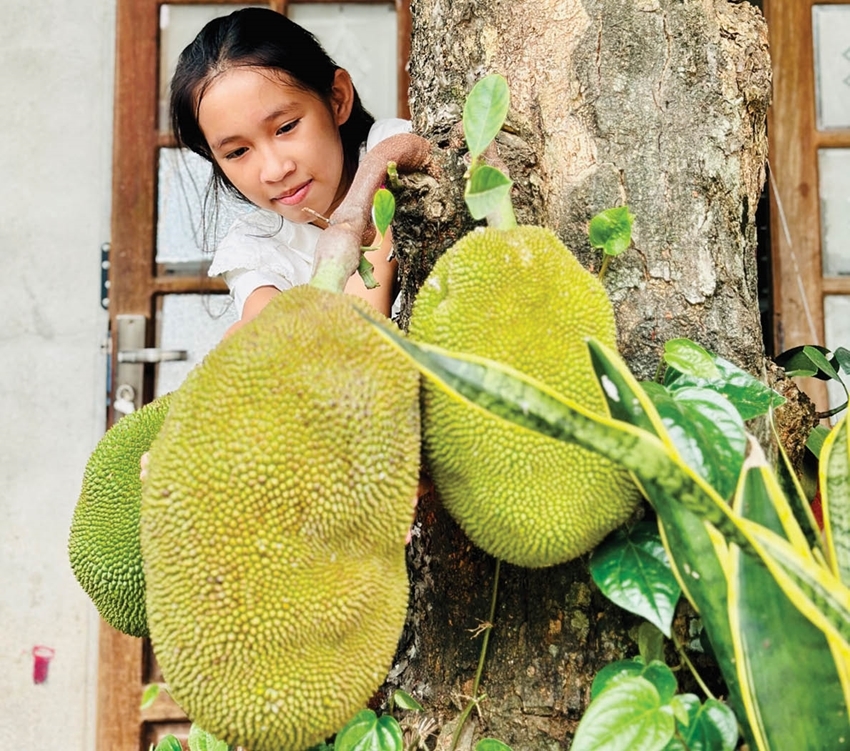 |
| Most gardeners in Hue grow jackfruit as a self-sufficient food source. Photo: MC |
Like many other regions, every July and August is the season of ripe jackfruit in Hue. In Hue gardens, there are usually two types of jackfruit: wet jackfruit and dry jackfruit.
To eat wet jackfruit properly, you have to cut it lengthwise, after gently peeling off the core, use chopsticks to pick up each ‘bulb’ and dip it in white salt to eat. The sweetness and slight stinging sensation on the tip of the tongue are the unique tastes of wet jackfruit. There are more types of dried jackfruit: Coconut jackfruit has thick and crispy bulbs, turmeric jackfruit is golden yellow, honey jackfruit oozes out the sweet taste when we bite a bulb. Compared to wet jackfruit, the way to eat dried jackfruit has certain differences. When cutting the rind and removing the core, Hue people often use banana leaves or fig leaves to put the jackfruit on and wipe off the latex. In particular, the mesocarp layer is very popular with children. The jackfruit rags are not thrown away but is stewed with fresh mackerel by grandmothers and mothers or used to make vegetarian dishes: stewed jackfruit rags or jackfruit rags sausage. Jackfruit rags are also carefully dried; and when winter comes, they are stewed with fish.
Jackfruit seeds are also a “preserve food” for Hue people. Fresh jackfruit seeds, after peeling off the outer layer and boiling them with a pot of cassava or sweet potatoes, are enough for the whole family to have breakfast. The fragrant, fatty, salty dried jackfruit seeds buried in the winter fire are a rich memory of many generations of Hue people. More elaborately, after boiling, peeling, pounding and roasting the jackfruit seeds with spices, they are squeezed into small balls, stuffed into jackfruit bulbs (just ripe), spread with honey, tied with green onions and steamed. This is a “royal jackfruit” dish with a strong Hue flavor that not everyone has the opportunity to enjoy.
Hue people also have many ways to eat young jackfruit: fried young jackfruit, boiled young jackfruit with soy sauce, shrimp paste or fish sauce, thinly sliced and mixed with sesame or peanuts; young jackfruit cooked with shrimp or meat soup with piper lolot leaves, etc. Planting each jackfruit tree in the garden is often included in the homeowner's calculations about columns, beams, rafters, purlins, cabinets, beds, tables, chairs, etc., so that after a few decades, there will be a spacious wooden house. Beautiful color, high hardness, fine wood grain, low expansion, etc., are the reasons why homeowners prioritize using wood from this type of tree.
Not only home gardens, Hue pagoda gardens also grow a lot of jackfruit. In addition to being a self-sufficient food source, jackfruit is also a spiritual tree, a symbol of Buddhism. Jackfruit is an abbreviation of the word Pāramī in Sanskrit (transliterated into Sino-Vietnamese as Ba la mat - 菠 蘿 蜜). Pāramī (Ba la mat) is a concept related to Bodhisattva practice in Buddhism. Depending on the sect, Pāramī or the Paramita of Practice can have 4, 6 or 10 virtues, of which the Practice of Giving (Dāna Pāramī) is the leading virtue. The color of the kāsāva robe (caysāra) is also often compared to the yellow color of the jackfruit core. The wooden bell used for chanting sutras in pagodas and other dharma instruments such as boards and bell-clubs are also made of jackfruit wood. Jackfruit wood is also the preferred choice for making worship objects in pagodas and private homes. In Hue, there is also a special pagoda named Ba La Mat. This must be the intentional naming of the founder - Vien Giac Dai Su Nguyen Khoa Luan (1834 - 1900).
In speech, it is easy to come across comparisons of money to jackfruit leaves, solid jackfruit (stupid), wet jackfruit (whiny), round as a jackfruit seed (body shape), firm as a jackfruit seed (personality), etc. And, it is no coincidence that jackfruit is also the fruit engraved in the Cao Dinh - a bronze royal urn placed in the center of The Mieu courtyard, cast by Emperor Minh Mang in 1836.
